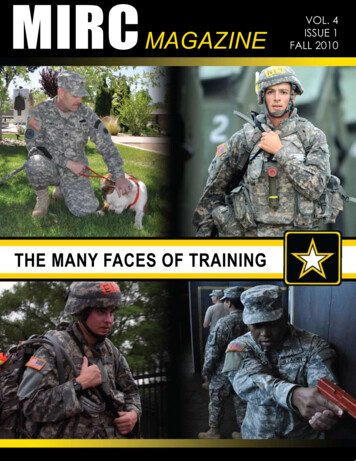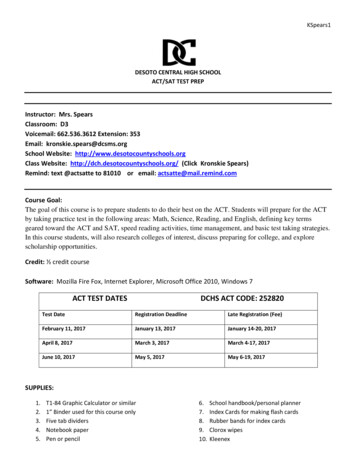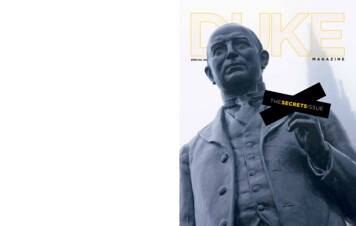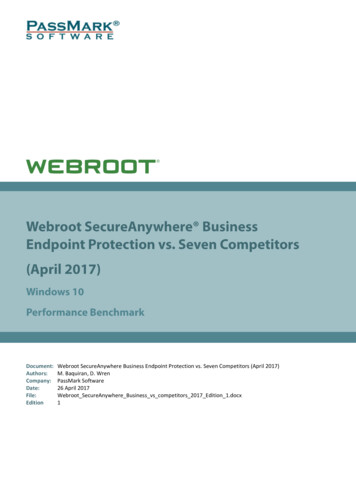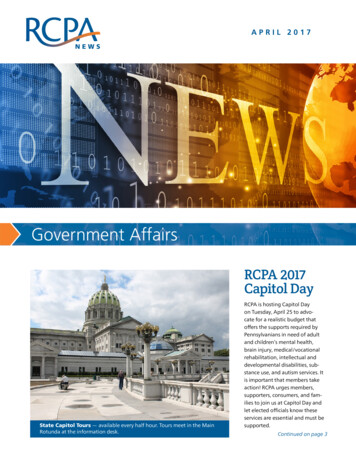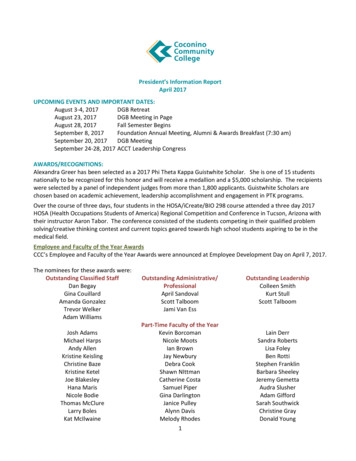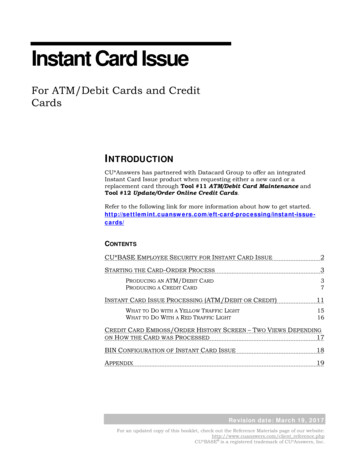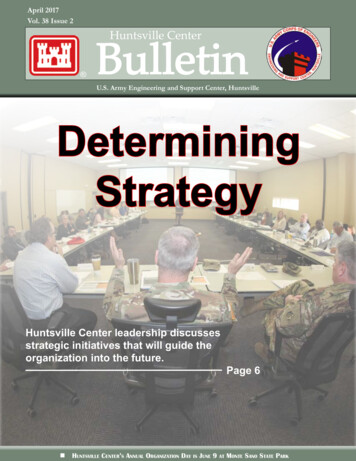
Transcription
April 2017Vol. 38 Issue 2Huntsville Center BulletinU.S. Army Engineering and Support Center, HuntsvilleDeterminingStrategyHuntsville Center leadership discussesstrategic initiatives that will guide theorganization into the future.Page 6n Huntsville Center’s Annual Organization Day is June 9 at Monte Sano State Park
Table of ContentsLeaders meet to determine way ahead.6Center’s programs director Ford retires.8Reach out call saves Army post valuable resources.10Elliott retires after 37 years’ service to USACE.11FRP receives Best In Class designation.12BASEOPS virtual industry day successful.13Negotiations reduce utility costs for USACE pumping station.14Center “Engineering Solution” tracks OPORDS.15Martin selected for senior executive program.17Center continues closing books on contracts.18Project manager goes where he’s most needed.19Contracting officer wins Secretary of the Army award.20Contract specialist chosen for developing leader program.21Fearns’ solutions recognized with award.22Hail and farewellFarewellMerton Cota, Mary Johansen, Benjamin Wissenburg, Environmental & Munitions Centerof Expertise; Felicia Culbertson, Oksana Joye, Brittney Cowan, Melinda Windham,Cener Contracting; Sherry Page, Office of Counsel; Derek Prosser, Executive Office; DwayneFord, Marvene Seaman, Environmental & Munitions Center of Expertise; Lary Quick, JamesCroom, Michael Eisenzimmer, Horace Spoon, Linden Torchia, Engineering Directorate;Charles Ford, Programs Director; Al Neva, Business Management Office; Clint Kimbrell,Installation Support and Programs Management DirectorateOn the coverPhoto by Michael May.2 BUILDING STRONGApril 2017
Commander’s thoughtsTeam,First of all, I want to congratulateall the employees who areparticipating in my fitness challenge.Fitness and well-being are veryimportant. I think we all benefit whenwe make healthier life choices (whetherthat is eating habits, stress management,exercise or quality of sleep), and we arelucky to have a facility here in Huntsvillewhere you can take advantage of classescoordinated by your fellow employees.If you have not yet joined the challenge,check for an email from the fitnesscenter. It’s not too late to sign up!Huntsville Center senior leadersrecently met for two days to help mecome up with a strategic way aheadfor the Center. We identified seventopics for development as strategicinitiatives: Huntsville Center governancestructure, strategic engagementand communication plan, projectmanagement transition, third-partyfinancing center of expertise, medicalmilitary construction staffing andorganization, a human capital plan thatincludes the action plan in responseto the Federal Employee Viewpointand Defense Equal OpportunityManagement Institute surveys, and theAcquisition Gateway. We will presentthese initiatives to HQ USACE whenthey come to Huntsville in May forthe Command Strategic Review andwe’ll meet again in June to assess ourprogress.Additionally, we reviewed anddiscussed our mission and visionstatements. The mission statementcaptures what we are tasked to do today,and the vision statement describeswhat we should look like in 3-5 yearsthat will enable us to execute ourfuture workload. I approved a minoramendment to our mission statement toemphasize our support to the Nation.It reads: The U.S. Army Engineeringand Support Center, Huntsville providesspecialized technical expertise, globalengineering solutions, and cutting edgeinnovations through centrally managedprograms in support of nationalinterests.In the vision statement, I want toemphasize to everyone the importanceof certifications and our ability to bethe organization that others turn tofirst for innovation and leadership. Thevision statement reads: A certified,professional work force with anexpeditionary mind-set capable ofpioneering solutions to unique, complexand high risk missions in strengthenedpartnership with the USACE enterprise,key DOD stakeholders and our strategicallies.It is time for us to complete myinitial Army Readiness AssessmentProgram (ARAP) survey. Thissurvey is important to me because itwill provide me with your valuablefeedback regarding our organization’ssafety climate, as perceived by you.Information will be sent to you by emailwith a suspense of April 14. Yourcandid feedback is critical to our effortsto assess and improve the safety culturewithin the Center. I appreciate yoursupport. I know there are numeroussurveys – but your vote counts! Takethe time to complete the surveyIn April we will officially sign thecollective bargaining agreement with theunion. It has been a couple of yearswith a lot of hard work negotiatingthe agreement. I look forward to thisimportant milestone.The Huntsville Center Bulletin is printed by digital copier as an officialpublication authorized under the provisions of AR 360-1. Opinionsexpressed are not necessarily those of the U.S. Army. Inquiries can beaddressed to Public Affairs Office, U.S. Army Engineering and Support Center, Huntsville, Attn: CEHNC-PA, P.O. Box 1600, Huntsville, AL35807-4301. Phone: DSN 760-1692 or commercial 256-895-1692. TheBulletin is also online at www.hnc.usace.army.mil. The Huntsville CenterFacebook page is located at http://bit.ly/HNCfbPage. The Twitter page islocated at http://twitter.com/CEHNC. Circulation: 500.April 2017 Col. John S. HurleyWe said farewell to Charles Ford,our programs director, March 3, afternearly 40 years as a federal employee.Because of the hiring freeze, we werenot immediately able to permanentlyfill this position, therefore we havetemporarily assigned Albert “Chip”Marin to the acting programs directorposition. With Chip moving to theprograms director position, ArthurMartin assumed the role of actingdirector of the Installation Support andPrograms Management Directorate.We also said farewell to Gina Elliott,who retired March 31. She served inmany key positions in her 37 years offederal service, to include acting deputycommander between the departure ofLt. Col. Bill Burruss and the arrival ofLt. Col. Burlin Emery.Both Charles and Gina will begreatly missed.We’ll have the annual organizationday picnic, June 9, 10 a.m., at MonteSee “Commander” on page 5BULLETINCommander. Col. John S. HurleyChief, Public Affairs. Debra ValineEditor. William S. FarrowPrinted on recycled paper30 percent post-consumerHuntsville Center Bulletin3
Employee Spotlight :James “Jay” ClarkBy Susan L. FollettSpecial to the BulletinWhat began as a summer jobwith the U.S. Army Corpsof Engineers turned into acareer for James “Jay” Clark, thanks toa boss’s encouragement and an earlyassignment that provided a youngarchitect the opportunity to do morethan just design rest rooms.Clark is Huntsville Center’s InteriorDesign Branch chief. However, hestarted with USACE as a summer hirein 1982 while he was in college.“I only expected to be there for thatone summer,” he said. “But I receiveda nice letter of commendation for thework I had done, plus my boss had toldme he really wanted me back the nextsummer, so I reapplied and came backthe following year.”After a couple of summers, Clarkwas offered a temporary position at ahigher level than most young architects.“Also, I had been involved in actualdesign projects, not just doing toiletdetails like would have been the case ata large architectural/engineering firm,”he said.“Even before I graduated, I was putin charge of a project at Fort Sill,Oklahoma, to develop final workingdrawings.”Much of Clark’s work over the past30 years has been in standarddesigns for several types of facilities,including physical fitness facilities,child development centers, school-agecenters, youth centers and fire stations.“Developing these standards has ledto major improvements in the qualityof life for Soldiers and their familiesacross the Army while at the same timeconserving taxpayer dollars,” he noted.Courtesy photoHe was also involved in establishingcentralized procurement of furniturefor unaccompanied housing, providinga uniform level of quality and durablefurniture across the Army, and reducingthe amount of money the Army spendson furniture.His work has taken him to physicalfitness facilities in Germany,Department of Defense schools inPuerto Rico and planning meetingsin Alaska, as well as sites across theUnited States for a range of projects.He credits his career longevity to thatdiversity, and to the satisfaction of ajob well done.“I think what is most memorablefor me now are the facilities thatwere built in the last 10 years to thestandards I developed,” Clark said.“I find it very rewarding to visitthose facilities now that they’recompleted: to hear all of the positivefeedback and to hear from the facilitymanagers how popular the new facilityhas become, mainly due to a number ofthe features that I incorporated withinmy standards.”One of the biggest changes he hasseen over the past four decades istechnology.“We used to draw on Mylar sheetsusing plastic lead in our mechanicalpencils. Everything was done by hand.”Clark was one of the first architectsin the Corps to use computer-aideddesign and drafting (CADD) when itwas introduced to the organization inthe mid-1980s, and he used it to createthe first standard designs.“In fact, to make the drawings lookbetter, I created the drawings on CADDand the verbiage on a word-processingtype of computer, and stuck the textonto the drawings with clear sheets.”The other noteworthy change is therole of the architect in USACE.“When I started back in the Tulsa(Oklahoma) District in 1982, they hadjust created the Architectural Section,and we only had one or two licensedarchitects. The role of the architectwithin USACE at that time was also notwell known or defined. Over the years,the value of the architect to a productteam has become much more apparentand accepted.”In the summer of 2016, he appliedfor a promotion to serve as chief of theCenter’s newly formed Interior DesignBranch and was selected. The newrole represents a big change, managingnearly 30 interior designers and handlingarchitectural designs, criteria and review,but it is one that Clark takes on withouthesitation.“When I started here, architecturewasn’t a common profession withinthe Corps. Over my years here, I havehelped grow the role. Now I feel it’stime for me to give back. Interior designhas not had a predominant role in theCorps, and I’m really committed tothis great group of designers and tochanging that culture, like thearchitects did.”The Employee Spotlight is intended to let Center employees shine for positively impacting the organization through mission achievements. Employeesare featured quarterly in the Huntsville Center Bulletin. If you’d like to nominate someone within your office for this recognition, please contact William S.Farrow, Public Affairs Office, at 256-895-1694, or email: william.farrow@usace.army.mil.4 BUILDING STRONGApril 2017
The Bulletin asks:What did you take away from attending the ProjectDevelopment Team Boot Camp March 29?““Coming from outside U.S. Army Corps of Engineers and starting my firstjob in the federal government in November, PDT Boot Camp answeredmany questions I had about Huntsville Center and its mission. From apublic affairs perspective, it was eye-opening to see the amount of workand coordination the professionals of the Center put into seeing theirprojects through to a successful completion. I came away with a moresolid understanding of and respect for the people working for the Center.Mark ThompsonPublic Affairs OfficeI thought it was an excellent general overview of the variousdepartments within the Center. It helped me understand the benefitof communication, an integral and vital ingredient for the overallsuccess of project execution from inception to completion.““Karim ManjiCommercial Utilities ProgramIt clarified how all the divisions in the Center work together, formingProject Development Teams to meet the ever changing needs of ourcustomers. I walked out with a better understanding of the importance ofthe Public Affairs Office in the Center’s success; how scheduling impactspost-award performance; why a Strong Matrix PDT is the best PDT; andthe golden rule: Communicate! Communicate! Communicate!““Brecken BaileyFacilities DivisionCommanderContinued from page 3Sano State Park. Current and retiredemployees are welcome. Requests fornominations for the Engineer DayAwards was sent out by email March28. Please take some time to think ofApril 2017employees who have done exceptionalwork over the past year and nominatethem in the correct category. Also,volunteer to assist the Huntsville CenterActivities Association with planning andexecuting the day. It takes a lot of folksto make this a fun day for everyone.There has been a lot going onaround the Center since my lastCommander’s Column. I appreciateyour hard work and dedication to theHuntsville Center. Essayons!Huntsville Center Bulletin5
HNC News Photo by Michael MayCol. John S. Hurley, Huntsville Center commander, unveiled his concept for a briefing chart that breaks down HuntsvilleCenter’s missions by portfolio at the start of day two of the Center’s two-day strategic off-site March 23.Leaders meet to determine Center’s way aheadBy Debra ValinePublic Affairs OfficeLeaders from the U.S. ArmyEngineering and Support Center,Huntsville, gathered March 23 –the second day of a two-day off-site –to discuss strategic initiatives that wouldguide the organization into the future.Huntsville Center Commander Col.John S. Hurley opened the discussionsFeb. 22 – the first day of the off-site –by asking: “Are there a couple of thingswe can work on, i.e., organizationalchanges, staffing, processes, that we canput in place that will put us in a betterposition to execute 18-36 months downthe road?”To answer the questions, the off-sitekicked off with each of the directorspresenting an analysis of where theirprograms are and introducing actionitems to be further researched.Taking into account the informationpresented during the day, the leaderscame up with 16 action areas to beexplored by project delivery teams todetermine which actions to pursue.“We are going to focus on a finitenumber of opportunities, appointpeople/teams, and give them a monthto flesh out the details,” Hurley said inFebruary.“It is acceptable to come back in amonth and say it isn’t something we cando because of timing, issues, project,etc.”The 16 action items introduced inFebruary yielded 13 topics fordiscussion March 23“We identified the seven strategicinitiatives we will pursue for the nextfew months,” Hurley said.Hurley said he would present theinitiatives to the U.S. Army Corps ofEngineers deputy commanding generaland senior staff at the commandstrategic review scheduled for May, andtalk about all the initiatives, what Centerleaders learned about themselves andthe results of these discussions.The initiatives identified were HuntsvilleCenter’s governance structure, strategicengagement and communication plan,project management transition, thirdparty financing center of expertise,medical military construction staffingand organization, a human capital planthat includes the action plan in responseto the Federal Employee Viewpoint6and Defense Equal OpportunityManagement Institute surveys, andAcquisition Gateway. In a few months,the group will meet again to assessprogress.n The governance structure team willlook at information and decisionmaking procedures that exist in theCenter’s governance structure. Thegoal is to have the forums and decisionmaking bodies in place to shareinformation, make corporate decisionsand then disseminate those decisionsand information, and ensure unity ofeffort.n The strategic communication andengagement initiative will review themeans and methods the Center uses tocommunicate with the U.S. Army Corpsof Engineers headquarters, USACEDivision and District commands, andkey external partners and stakeholderson a regular basis. The goals are tocreate the most efficient and effectivemeans of communicating with thesekey organizations, ensure the Center’sefforts are fully integrated with otherUSACE and Defense activities, assessthe quality of our relationships and BUILDING STRONGContinued on page 7April 2017
HNC NewsOff-siteContinued from page 6make investments to improve relationships.n A project management transition initiative will look at therisks and vulnerabilities inherent in the transition of projectsbetween teams or the transition of individuals on andoff teams. While looking at lessons learned is a necessarycomponent of the initiative, this focus area must analyze andminimize the inefficiencies inherent in transitions with a goalof increasing project quality and minimizing expense.n The Center will explore the utility of developing a centerof expertise for third-party financing that any USACE activitycan leverage. Because Huntsville Center’s Energy Division isexperienced in this type of contracting, a group will explorethird-party financing other areas and collaborate with HQ andother elements of USACE in order to develop the technicalexpertise to use third-party financing across the enterprise.n As the need for federal medical construction continues togrow, it is critical that Huntsville Center build the benchin medical expertise in all career fields to support medicalconstruction programs. The Center must have qualifiedtechnical staff to be able to support USACE Divisions andDistricts execute their new medical construction programs,while maintaining sufficient staff to support our medicalfacility renovation programs, said Boyce Ross, Engineeringdirector.n The leadership recognized the need to comprehensivelyupdate its human capital plan. According to Jen Haapoja,Human Capital chief, 16 percent of the workforce can retirenow, and another 35 percent will be eligible to retire withinin five years. Additionally, the nature of the work that theCenter executes continues to adapt to the changing needs ofthe Center’s stakeholders. As a result of these realities, theneed for a robust and executable succession plan has neverbeen greater. Further, the leadership recognized the need toensure the human capital plan was informed by the issuesidentified in the FEV and DEOMI surveys. Together, thisplan will position the Center for future success.n Todd Watts, Facilities Division chief, presented how theGeneral Services Administration’s Acquisition Gateway canbenefit 33 of the Center’s 42 program areas.The Center recently received the Army’s only Best-inClass Designation for its Facilities Reduction Programcontract vehicles.Watts suggested taking advantage of the opportunity toexpand the Center’s participation before use of theAcquisition Gateway becomes mandatory and the availablecontracting vehicles may not meet the Center’s needs.“We will see how we are doing on these strategicassessments,” Hurley said. “We are having our CommandStrategic Review in May, and I would like to be able to presentour strategic initiatives then.April 2017Photo by Michael MayLee Tew, Center Contracting, briefs attendees on informationflow at the Huntsville Center off-site March 23.“I approved a minor amendment to our mission statement toemphasize our support to the Nation,” Hurley said. It reads:The U.S. Army Engineering and Support Center, Huntsvilleprovides specialized technical expertise, global engineeringsolutions, and cutting edge innovations through centrallymanaged programs in support of national interests.“In the vision statement, I want to emphasize to everyonethe importance of certifications and our ability to be theorganization that others turn to first for innovation andleadership,” Hurley said.The vision statement reads: A certified, professional workforce with an expeditionary mind-set capable of pioneeringsolutions to unique, complex and high risk missions instrengthened partnership with the USACE enterprise, keyDOD stakeholders and our strategic allies.Huntsville Center Bulletin7
HNC News Center’s programs director Ford retiresBy William S. FarrowPublic Affairs OfficeAfter nearly four decades of service to hisnation, Charles Ford, Huntsville Center’sprogram director, retired March 3.However, Ford isn’t just retiring from a career,he’s stepping away from the U.S. Army Corpsof Engineers, the organization with the greatestimpact on his life.“I wanted to be an Army Engineer. That’s whatmy dad did for 20 years, and that’s what I wantedto do. He was a lieutenant colonel in the Corps ofEngineers,” Ford said.Ford grew up a military brat – a term ofendearment used to describe the child of a parentor parents serving full-time in the U.S. ArmedForces. As a brat, Ford experienced a mobileupbringing with extensive exposure to foreign andAmerican regional cultures, and developed a loveof traveling.He also grew up with a heightened sense ofpatriotism and a pursuit of a service-related career.“I was born in England, and lived in threecountries, three states and one U.S. territory beforemy father retired from the Army and settled inMontgomery, Alabama, to take a job with thestate,” Ford said.Following graduating from Jefferson DavisHigh School in Montgomery in 1972, Fordattended Auburn University where he enrolledin the Army Reserve Officer Training Corps.In December of 1976 he earned his bachelor’sdegree in civil engineering, was commissionedin the Army as a second lieutenant and marriedRhonda, his college sweetheart. After obtainingan educational delay from the Army, Ford wenton to obtain a master’s degree in geotechnicalPhoto by William S. Farrowengineering before going on active duty in 1978.Charles Ford, Huntsville Center’s programs director, retired March 3.With his initial training at Fort Belvoir,opportunities to do so as an Army officer just were notVirginia,complete, his first assignment was as theavailable.facility engineer with the 558th Artillery Group in Athens,Ford made the decision to transition out of the active dutyGreece. The assignment allowed Ford and his new bride,Armyin 1984 and began looking for engineering work thatRhonda, to travel extensively throughout Greece as well aswasrewardingprofessionally and would allow his family totaking trips to Turkey, Egypt, Israel and the Soviet Union.see more of the world. He took a civilian position at FortRhonda, a Montgomery native, knew she wanted to travel,Belvoir working in the systems division at the U.S. Armymaking assignments overseas more interesting and exciting.Facility and Engineering Support Agency.The Fords returned to Fort Belvoir in 1982 where heWithin a year, Ford accepted a position overseas with theserved for two years as the Prime Power Production SpecialistUSACE Turkey Area office at Incirlik Air Base. Ford andschool commandant. However, he and his wife knew theyhis family called Turkey home for five years, followed by awanted to return overseas as soon as possible, but theContinued on page 98BUILDING STRONG April 2017
HNC NewsFordContinued from page 8project manager position at a USACEoffice in Germany and a return toTurkey for another four-year assignmentwhere he said he held all the positions acivilian engineer could hold in the areaoffice there.“I found it all very rewarding. All thejobs overseas, and especially in Turkey,taught me a lot about construction,how to deal with contractors andstakeholders, and how an installationoperates,” Ford said.With twin daughters reaching theirteens, Ford said he and Rhonda knew itwas time to return to the states.“You enjoy living overseas, but youmiss family,” Ford said. “I wanted tobe near home and I knew some peoplehere in Huntsville. After more than 15years working overseas I had gaineda significant amount of experiencein both project management andconstruction and because HuntsvilleDivision supported some of myprojects in Turkey I had knowledge ofthe Huntsville mission.”Ford said he was willing to accept adowngrade from a GS-14 to a GS-12 tomove to Huntsville Division.“My family comes first. Huntsville’sa nice town, and the Center had agreat mission, so in December of 1996I began working here at HuntsvilleDivision in the medical program as aproject manager,” he said.In 1997, after USACE designatedHuntsville Division as the Engineeringand Support Center, Huntsville, Fordbegan working the Center’s ChemicalDemilitarization mission climbing theladder from alternate technology chiefto deputy director.However, before becoming deputydirector, he had the opportunity towork on a very unique project that tookhim back overseas.In 1998 the U.S. governmentassigned the Huntsville Center as theU.S. construction oversight agent forchemical demilitarization activities inApril 2017the former Soviet Union.“The Center was tasked to providecontract planning, management andon-site program management forconstruction of the Russian ChemicalWeapons Destruction Complex atShchuch’ye, Russia,” Ford said. “Iwas detailed to the site east of UralMountains where I was the first sitemanager, and I kicked off constructionon the site.”Ford said the project was uniquebecause he was working with Russianengineers and contractors to build aplant to dispose of Russian chemicalweapons.“We were in charge of facilityconstruction, and the Russians werein charge of the demilitarizationoperations there,” Ford said.“I was only there from Januarythrough June before turning it overto subsequent site managers but itwas a great learning experience. Therewere a lot of construction practicesin Russia that were totally alien tome. Living in different countries, Ilearned about engineering techniquesand learned there are ways to do thesame thing differently, but this wasvery different. I questioned some ofthe things they were doing, requiringthat they demonstrate their methodswere allowed by their codes. So I hadto adapt to different constructionmethods, allow the contractor to dotheir job and at the same time deal withthe Russian government. It was veryinteresting assignment.”Ford returned to the Center as thedeputy chief and subsequently Directorof the Chemical Demilitarizationprogram.While in the position as chief, Fordsoon targeted a specific Center positionthat had not even been created.“Jim Cox was the business director,and he was looking at creating a projectmanagement directorate, and he askedme for my advice on how to organizeit,” Ford said.“After I helped him in the planningand laying it all out, I told him ‘I wantthat job (directorate chief).’ It wasn’ta pay raise, it was a grade equivalentposition to the one I was in, but it wassomething I thought I was suited to dobecause I was passionate about projectmanagement.”Ford stayed in the position asdirector of what eventually becamethe Installation Support and ProgramsManagement Directorate untilbecoming the Center’s ProgramsDirector, the senior civilian position atthe Center.However, he said when he took hisfirst job at the then Huntsville Division,he and his wife never expected to be inHuntsville more than three years.“Huntsville Center is dynamic. Withan ever changing work environmentand mission requirements, the Center isable to adapt. I moved from job-to-jobat the Center, and I really enjoyed everyposition I had and before you know it,20 years passed,” he said.“I love the Corps of Engineers.Earlier in my career I had opportunitiesto leave the Corps for higher gradepositions with NASA and GSA,declining both to stay with the Corps.I liked the professionalism of theCorps, the mission of the Corps andthe locations where the Corps operates,and the more I worked with otheragencies, the more I realized the Corpsof Engineers is unique.”In retirement, Ford said initially hewill concentrate on home improvementprojects.He said he also wants to give moretime to his church. Joined by Rhonda,he will continue to travel.Ford said he always knew he wantedto be in the Army Corps of Engineersand to travel.For most of his life that’s what hehas done.“I was born in the Corps; mybirthday is the same as the Corps’birthday. It’s a fabulous organization.I’m going to miss the Corps.”Huntsville Center Bulletin9
HNC NewsReach out call saves Army post valuableresources, enhances force protection By William S. FarrowPublic Affairs OfficeWith a simple phone call, aHuntsville Center projectmanager prevented the lossof use of vital access control points foran extended period of time as well aspotentially saving her customer millionsof dollars.After the Army Office of theProvost Marshal General requestedthat Huntsville Center Access ControlPoint Program look into Reilly Roadand Canopy Lane road projectsat Fort Bragg, North Carolina,Heather Wilburn was assigned asproject manager to provide oversightfor design-build construction andinfrastructure upgrades for the twoaccess control points at the largestmilitary base by population on earth.Wilburn learned from Fort Braggofficials that an agreement madebetween Fort Bragg and the NorthCarolina Department of Transportationmore than 20 years ago requi
expressed are not necessarily those of the U.S. Army. Inquiries can be addressed to Public Affairs Office, U.S. Army Engineering and Sup-port Center, Huntsville, Attn: CEHNC-PA, P.O. Box 1600, Huntsville, AL 35807-4301. Phone: DSN 760-1692 or commercial 256-895-1692. The Bulletin is also online at www.hnc.usace.army.mil. The Huntsville Center


